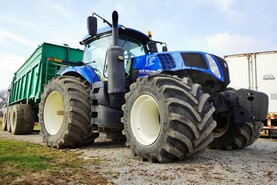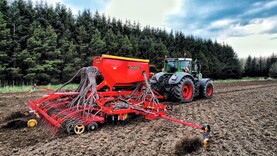The current spell of fine weather is letting farmers bring field work up to date. On farms where grassland swards were damaged last autumn, or grass growth has been poor in recent years, then now is an ideal opportunity to reseed ground. Outlined are some tips to making the most of a reseeded sward.
1 Address drainage and soil compaction
First off, there is little point in reseeding a field if there is a major issue with soil drainage or compaction. New grass will not magically solve underlying drainage problems.
Does surface water lie on the field and is it slow to drain away? Is grass growth patchy or slow to respond to fertiliser?
Dig a few test holes around the field and see if there is a compaction issue. Are grass roots condensed in the top few inches of soil? Does soil appear layered with horizontal fissures?
If so, then soil is compacted and will hold water, rather than letting it drain off. A sub-soiler, or pan buster, will rectify this problem. If compaction is deeper, then ploughing is necessary.
If drainage is the issue, then install new drains before reseeding. These can be in the form of mole drains, or pipe and stone channels.
For best results, burn off the old sward before ploughing or stitching in new grass. This will reduce the carryover of weeds and natural grass in the reseed.
If the field has received fertiliser, slurry or has been recently grazed, then there is little point in taking a soil sample before reseeding. The results will be distorted by nutrients originating from fertiliser or livestock.
However, it is worthwhile applying lime before reseeding. This can be worked into the soil after ploughing.
Lime is recommended for any reseeding work where grass seed is stitched into an existing sward. The dead grass can make the seed bed acidic which impacts on germination rates.
Applying farmyard manure will increase organic matter and provide P and K for seed establishment. If this is not an option, use a compound NPK fertiliser to dress the seed.
4 Choosing the right variety
There are numerous grass varieties and mixes available, so make sure you choose one to suit our soil and the sward's purpose.
Tetraploid grasses tend to grow tall and erect, making then ideal for silage. However, they leave swards open at the base, making them less suitable for grazing.
Diploids are suited to grazing, especially on heavier soils. Choose a mix with medium- and late-heading varieties for silage and grazing.
Apply a good herbicide once grass has established. This will control weeds from getting a foothold. If you want to retain clover, then be sure to use a clover safe product.
This will be more expensive that regular sprays. The alternative is to apply a general spray to target weeds and then stitch clover in to the sward afterwards.
Read more
UK determined to proceed with Brexit
Grass growth and live exporters drive cattle demand
The current spell of fine weather is letting farmers bring field work up to date. On farms where grassland swards were damaged last autumn, or grass growth has been poor in recent years, then now is an ideal opportunity to reseed ground. Outlined are some tips to making the most of a reseeded sward.
1 Address drainage and soil compaction
First off, there is little point in reseeding a field if there is a major issue with soil drainage or compaction. New grass will not magically solve underlying drainage problems.
Does surface water lie on the field and is it slow to drain away? Is grass growth patchy or slow to respond to fertiliser?
Dig a few test holes around the field and see if there is a compaction issue. Are grass roots condensed in the top few inches of soil? Does soil appear layered with horizontal fissures?
If so, then soil is compacted and will hold water, rather than letting it drain off. A sub-soiler, or pan buster, will rectify this problem. If compaction is deeper, then ploughing is necessary.
If drainage is the issue, then install new drains before reseeding. These can be in the form of mole drains, or pipe and stone channels.
For best results, burn off the old sward before ploughing or stitching in new grass. This will reduce the carryover of weeds and natural grass in the reseed.
If the field has received fertiliser, slurry or has been recently grazed, then there is little point in taking a soil sample before reseeding. The results will be distorted by nutrients originating from fertiliser or livestock.
However, it is worthwhile applying lime before reseeding. This can be worked into the soil after ploughing.
Lime is recommended for any reseeding work where grass seed is stitched into an existing sward. The dead grass can make the seed bed acidic which impacts on germination rates.
Applying farmyard manure will increase organic matter and provide P and K for seed establishment. If this is not an option, use a compound NPK fertiliser to dress the seed.
4 Choosing the right variety
There are numerous grass varieties and mixes available, so make sure you choose one to suit our soil and the sward's purpose.
Tetraploid grasses tend to grow tall and erect, making then ideal for silage. However, they leave swards open at the base, making them less suitable for grazing.
Diploids are suited to grazing, especially on heavier soils. Choose a mix with medium- and late-heading varieties for silage and grazing.
Apply a good herbicide once grass has established. This will control weeds from getting a foothold. If you want to retain clover, then be sure to use a clover safe product.
This will be more expensive that regular sprays. The alternative is to apply a general spray to target weeds and then stitch clover in to the sward afterwards.
Read more
UK determined to proceed with Brexit
Grass growth and live exporters drive cattle demand






 This is a subscriber-only article
This is a subscriber-only article










SHARING OPTIONS: